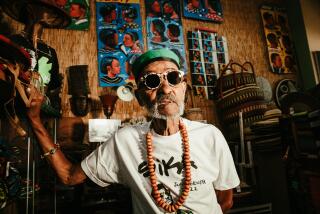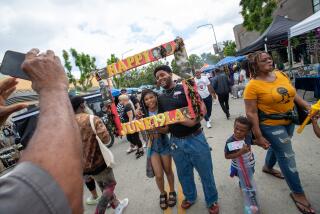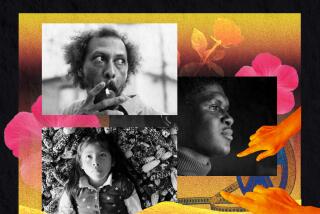LEIMERT PARK : Video Used as Tool for Self-Esteem
Recalling the roots of his filmmaking career, Ben Caldwell says his first inspiration was hardly the escapist stuff of most Hollywood movies.
“When I was in Vietnam in the ‘60s, I saw firsthand that warriors don’t die easy,” said Caldwell, 47. “I realized that killing is a lot more gruesome in reality. It stayed with me. I wanted to somehow do a film about that, particularly from the black perspective.”
That desire to show a different point of view steered Caldwell into filmmaking, and establishing Kaos Network, a “media house” that seeks to acquaint the community with the world of films, television and video. Through screenings, discussions, video workshops and other events, Kaos offers a means by which blacks--especially youngsters--can change the frequently distorted images of themselves that pervade the media, Caldwell said.
“We always say that our kids are controlled by images in the media but nobody really analyzes them,” Caldwell said. “At Kaos, we talk about what’s really going on.”
With its hardwood floors, art-cluttered walls and eclectic mix of African music thumping over a sound system, Kaos has a coffeehouse feel. Audiences chat on the topics raised in the short films and videos Caldwell regularly shows--from an examination of the roots of rap to Caldwell’s own public-television production on the cultural history of Leimert Park.
Caldwell also aids community artists and young people in developing their own projects, regularly working with groups that have totaled about 3,000 over nine years.
Actor and performance artist Roger Smith said Kaos provides an important outlet for the community.
“I grew up three blocks from here, and I have a real love for this area,” said Smith, whose “Frederick Douglass Now” performance piece was developed at Kaos and is currently playing in New York. “Working with Ben has been a great collaborative process. And he has a real rapport with kids.”
A UCLA film school graduate and former communications teacher at Howard University, Caldwell settled in Los Angeles in 1984 intending to start a community-based film institution. With federal and state grants he founded Video 3333, a space on the edge of Leimert Park Village that focused on providing young people a place to explore film and video production and performance--all free.
With cameras, computers and editing equipment, the space attracted a core of budding artists--initially called “I Fresh”--including rappers Yo-Yo and N.W.A. Caldwell also helped his students fashion unusual uses for film, such as Smith’s “media assault” style of interweaving recorded video with live stage performance.
Though Caldwell dubbed his new performance space Kaos Network in 1990, Video 3333 remains the youth outreach wing and the heart of the operation.
One project Caldwell pioneered for teen-agers is “video imaging,” in which they videotape and critique themselves. “It’s a means for kids to see themselves instantly,” said Caldwell. “They objectively see how other people see them, also to be themselves and have fun. I call it a self-esteem machine.”
Don Kingski, a 28-year-old rapper, songwriter and producer, traces his success in the music industry directly to his days at Video 3333. “It really gave me the opportunity to hone my skills in video-making, especially through filming myself,” said Kingski, who became involved with Caldwell’s center in 1984.
Working with youths is not the only thing on Caldwell’s agenda; for this fall’s Los Angeles Festival, he plans to produce videophone segments that will allow audiences from other countries to communicate live with South-Central viewers. But he says this technology can be put to better use here.
“We can link gang members in the street to each other, to families, organizations, even other cities and nations,” said Caldwell. “They can reach their goals through media. We’ve all just got to update our brains, and think of media as a new tool.”
More to Read
Only good movies
Get the Indie Focus newsletter, Mark Olsen's weekly guide to the world of cinema.
You may occasionally receive promotional content from the Los Angeles Times.










